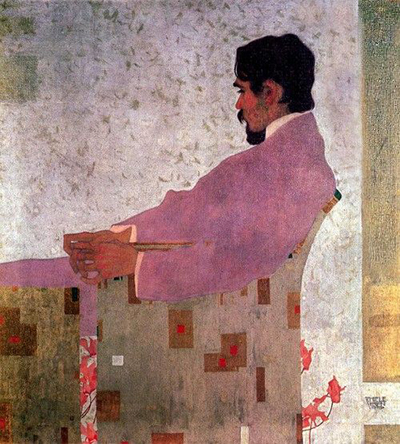Egon Schiele's portrait of Anton Peschka was painted in Vienna in 1909 at a time when the artist was starting to profit from his growing artistic reputation, mainly through working effectively within this genre.
Anton Peschka was a fellow Austrian painter who was a close friend of Schiele and was in the same class at the Academy of Fine Arts in Vienna. He was five years older than Schiele and eventually became his brother-in-law when he married Schiele's sister, Gertrude, in 1914. The portrait was included in Schiele's first public exhibition in 1909 in Vienna. The portrait is an oil on canvas painting in the Art Nouveau style that measures 100 x 110.2 cm. It is currently located in a private collection and was sold at Sothebys in 2001 for over seven million pounds. It shows a young man, Anton Peschka, seated in a large armchair with patterned fabric. He is facing to the side so that only his left silhouette can be seen in the painting. He wears a rose pink suit with a white collar and cuffs and his hands are folded together on the arm of the chair.
Peschka's hair, beard and moustache are painted in a deep black. Schiele uses mainly neutral shades of grey and beige in the rest of the painting, with a few small points of dark pink colour used in the fabric of the chair and in a pattern of foliage. This makes Peschka and his clothing stand out in a subtle contrast. Schiele also used red paint to highlight his subject's cheeks and the knuckles of his hands. The paint that Schiele used included a metallic finish that is used to add a silver and gold bronze sheen to the walls and the chair. The painting is obviously influenced by Gustav Klimt, who was Schiele's mentor, in its use of opulent pattern and colour. It is the decorative touches of differently coloured rectangles that adorn the exterior of the chair which directly remind us of some of the same use of detail that came from the original Austrian master - see The Kiss, Adele Bloch-Bauer and Fulfillment Stoclet Frieze for examples of this.
It was entirely common for artists to produce portraits of their colleagues, with them often being close friends, sometimes even becoming connected through family. The likes of Franz Marc and Gabriele Munter are good examples of this, having shared a relationship at one time. Schiele was also known to be a fairly charming person who would have enjoyed discussing art themes with fellow creatives, so long as they had earnt his trust and respect by that point. This particular portrait can now be found within a private collection and so will often now be accessible to the public, sadly. Some of these privately owned paintings do get loaned out from time to time, though, and so can be seen for a short period of time, and there are also many other Schiele paintings that remain in public displays in Vienna too.




